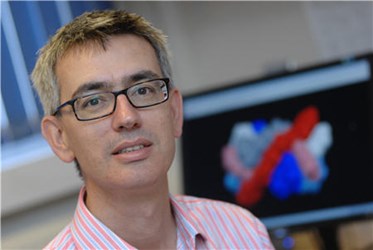Self-Assembling, Molecular 'Lego Death Star' To Combat Cancer
By Chuck Seegert, Ph.D.

Historically, artificial peptides have been incredibly difficult to manufacture, and while it was possible to do so, the cost involved didn’t make it worthwhile. Now a team of researchers at the University of Warwick has developed a method that takes only minutes to execute and requires no costly equipment. The peptides generated by this process mimic natural proteins and have proven effective in attacking colon cancer cells in the laboratory.
In addition to being cost prohibitive to manufacture, previous peptide drugs were attacked by the body’s biochemical defenses and were quickly neutralized before they could be effective. The Warwick team’s method, while being practical, also addresses this issue and produces molecules that are very stable. These stable peptide molecules are called triplexes and are very similar to the 3D form of natural peptides.
“The chemistry involved is like throwing Lego blocks into a bag, giving them a shake, and finding that you made a model of the Death Star,” said professor Peter Scott, the lead researcher of the Warwick team, in a recent press release. “The design to achieve that takes some thought and computing power, but once you’ve worked it out the method can be used to make a lot of complicated molecular objects.”
In the press release, Scott further described the process by saying: “When the organic chemicals involved, an amino alcohol derivative and a picoline, are mixed with iron chloride in a solvent, such as water or methanol, they form strong bonds and are designed to naturally fold together in minutes to form a helix. It’s all thermodynamically downhill. The assembly instructions are encoded in the chemicals themselves.”
The structure and function of the new peptide molecules was described in a research study published in Nature Chemistry. The triplex structure of these peptides was shown to be the key feature that imbued them with a structure-dependent toxicity against the human colon cancer carcinoma cell-line HCT116 p53++. This functional topology caused dramatic changes in the cell cycle without damaging DNA. The new molecule’s toxicity and the way it affects the diseased cells is similar to that seen in the active subunits of naturally occurring molecules like host-defense peptides and p53.
In the press release, Scott also said that the molecules displayed “very unusual and promising selectivity.” Testing with the human breast cancer adenocarcinoma cell line (MDA-MB-468) revealed a lower toxicity than in the colon cancer model. Additionally their toxicity to bacteria like methicillin-resistant Staphylococcus aureus and Escherichia coli was virtually non-existent.
Self-assembling processes are an active area of research in the cancer field. In addition to the biomimetic peptide structures discussed in this article, self-assembling nanoparticles have helped advance other medical fields like cancer diagnosis.
Image Credit: University of Warwick
